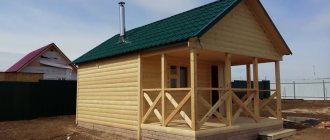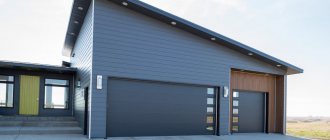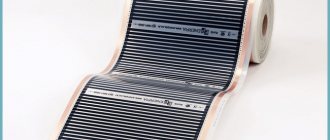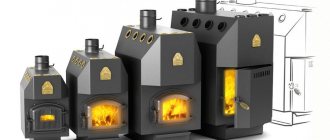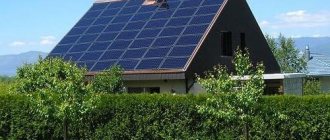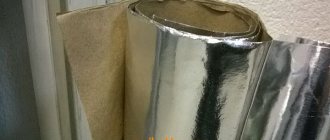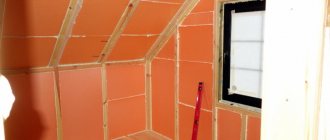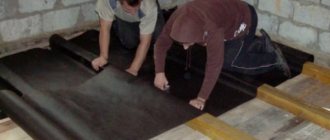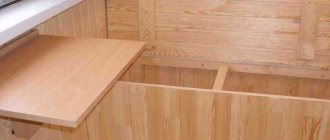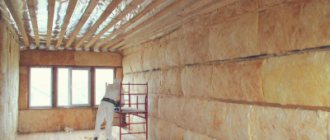The mid-90s of the last century was a turning point for the building materials market. Practical and inexpensive types of thermal insulation began to appear, for example, mineral wool, glass wool, and cellulose-based insulation. These materials attract the attention of buyers with their affordable price and relatively good characteristics.
However, there are also significant drawbacks. In particular, these are quite large materials, and the thickness of the insulation board “conceals” the interior space of the premises. In addition, such thermal insulation can dry out and become painted, which invariably leads to heat loss. Of course, mineral wool is still considered one of the popular thermal insulation materials today.
However, this is not due to high efficiency, but to an affordable price. If there is a need for really high-quality thermal insulation of premises, penoizol is used during construction. This is a liquid insulation material that is rapidly gaining popularity in our country.
What kind of thermal insulation material is this?
Let's start with definitions. The name "Penoizol" is a trademark of insulation created on the basis of urea resins. The material is in high demand, so it has become a household name, combining the following names:
- "Teploizol"
- "Mipora"
- "Unipor"
- "Mettemplast"
However, among professional builders, insulation is better known as liquid or poured foam.
In appearance, thermal insulation resembles marshmallows, which, after hardening, turns into an elastic mass that is guaranteed to fill all voids.
The composition of the insulation includes the following components:
- Urea resin
- Orthophosphoric acid
- Foaming additives
The ingredients are mixed in certain proportions and pumped into special cylinders where the mixture is under pressure.
Varieties
Thermal insulation of houses is carried out using different types:
1. Liquid. It is the most common and is manufactured directly on the construction site.
2. Sheet foam insulation. The basis for it is a liquid semi-finished product, poured into a regular cubic form. After hardening, the massif is cut into sheets of the required thickness. Cutting is carried out manually (with a string) or on machines. Then the sheets are dried and finished mechanically processed.
3. Granulated (crumbs, thermal wool). To make it, polymerized penoizol is crushed to a fraction of 10-15 mm - this size allows you to maintain elasticity.
Externally similar to expanded polystyrene, it is a white material with a fine-cell structure. But the technical characteristics of the two polymers differ significantly - this is clearly demonstrated in the table.
| Parameter, unit of measurement | Penoizol | Expanded polystyrene |
| Density, kg/m3 | 6-35 | 10-50 |
| Thermal conductivity, W/(m*K) | 0,012-0,041 | 0,037-0,042 |
| Operating temperature limits, °C | -50/+120 | -50/+80 |
| Compressive strength, kg/cm2 (at linear deformation 10%) | 0,07-0,5 | 0,14-0,75 |
| Water absorption per day, % by weight | 5,5-10 | up to 2.0 |
| Shrinkage,% (liquid penoizol) | up to 4 | 0 |
| Flammability group | G1-G2 | G1-G4 |
Technical characteristics of urea-formaldehyde foam (UFP)
It is believed that, in terms of its stated performance properties, penoizol is superior to any insulation available on the domestic market. The main characteristics of thermal insulation look like this:
- Thermal efficiency . The thermal conductivity of insulation varies between 0.031-0.041 W/m on the Kelvin scale. 10 cm layer of liquid foam to provide reliable insulation to the interior.
- Soundproofing . Penoizol absorbs up to 65% of street noise, which is considered a very good indicator.
- Fire safety . The material is not flammable and does not support combustion. However, when exposed to high temperatures, the insulation will simply evaporate without releasing toxic substances into the air.
- Dependence on chemical and biological factors . The insulation is neutral to any aggressive environment. In addition, the insulation is of no interest to rodents and is resistant to pathogenic microflora: fungus, mold.
- Moisture resistance . The material absorbs moisture well, but subsequently evaporates it without losing its original properties. Given this feature, it is recommended to install ventilation gaps to prevent the appearance of mold on the walls.
- Durability . Indicators of linear compression of insulation are 0.07-0.5 kg/cm2 . Accordingly, the material holds its shape well and quickly restores its structure.
Manufacturers claim that thermal insulation can last 30-50 years without loss of quality. However, insulation appeared on the market relatively recently, so there is no evidence of such an impressive service life yet.
Technical characteristics of penoizol
When they begin to consider the positive properties of penoizol (see photos, video reviews), the first thing mentioned is low thermal conductivity
. This is logical, since the main task of the material is to retain heat. If we compare it with similar insulation materials, we can come to the conclusion that it is superior to polyurethane foam, expanded polystyrene foam, and mineral wool. This is an excellent result, since the listed materials are also high-tech.
Next we should mention such an important quality of penoizol as high fire safety
. This is important because the problem with outdated insulation was that in the event of a fire, the walls began to burn from the inside - which is almost impossible to stop. The flammability group of our insulator is G2. Again, the material leads among its competitors. It is physically impossible to ignite it; it melts at high temperatures (> 210°C) and does not spread fire. It can also be noted here that smoke generation is also very low; The smoke, which is very important, is non-toxic.
Penoizol's rival in the field of sound insulation is polystyrene foam; they are almost identical, only the second one resonates at some frequencies due to the fact that the structure of its cells is not optimal in this regard. But still, both materials do not transmit sound waves
, as shown by numerous tests. This is due to properties such as softness and graininess.
- Thermal conductivity coefficient 0.028-0.04 W/m*K;
- Density - 8-25 kg/m3;
- Compressive strength at 10% linear deformation - 0.07-0.5 kg/cm2, with bending 0.10-0.25 kg/cm2;
- Operating temperature range - from -50°С to +120°С;
- Sound absorption - 65%;
- Water absorption - 10.5%;
Advantages and disadvantages of hardened thermofoam
The popularity of penoizol did not arise out of nowhere. Among the undeniable advantages of insulation are the following features:
- High technical properties - even a 45 mm can prevent heat loss.
- Resistance to dynamic loads - the elastic structure allows it to be restored to its original state even after prolonged compression.
- Neutrality to any external influences - sudden temperature changes do not affect the quality of the insulation.
- Excellent adhesion - thanks to its liquid structure, thermal insulation adheres well to any surface and fills all voids.
- Multifunctionality - insulation is suitable for any structure, regardless of geometric shape.
- Vapor permeability - when using penoizol, condensation does not form on the walls, which is very useful for wooden structures.
In addition, liquid foam does not form cold bridges.
Of course, it wasn't without its drawbacks. The weak points of insulation are:
- Shrinkage - after pouring, the volume of material can be reduced by 0.1-5%.
- Moisture absorption - when it comes to insulating the foundation, this parameter can be regarded as a disadvantage.
- Dependence on temperature conditions - you can work with penoizol only at air temperatures above +5 degrees .
- Low tensile strength - despite the elastic structure, the insulation is easily torn and pierced, which violates the thermal insulation performance.
The disadvantages include high cost. It is curious, but the price of insulation does not exceed the cost of mineral wool and other thermal insulation materials. However, pouring liquid foam requires special equipment, which private developers do not have.
Therefore, you have to rent equipment or hire a team of construction workers, which adds to the overall cost of the work.
Details
Advantages and disadvantages
Liquid foam plastic has many advantages, and also distinguishes it favorably from other types of thermal insulators. This material has the following advantages:
- Low thermal conductivity coefficient.
- Firmness and elasticity. Due to its properties, the foam will fill all voids and cracks, eliminating the appearance of cold air bridges.
- Resistance to mechanical stress. Under force load, the frozen material is crushed, and after the pressure is removed, it will quickly return to its original position.
- Resistant to sudden temperature changes and changes in humidity.
- Excellent steam permeability. Thanks to this property, condensation will not begin to accumulate on insulated wall surfaces.
- Excellent grip. The foam reliably and quickly adheres to any type of base, making it convenient for insulating buildings with complex structures.
- Excellent protection against fungal colonies and mold. There is no need to be afraid that insects may infest the insulation or that rodents may damage it.
- Favorable price. The raw materials for creating penoizol are inexpensive, which has a positive effect on the prices of the finished material. By installing a thermal insulator yourself, you can save a large amount on home insulation.
- Durability - properly installed thermal insulation material can last more than 50 years without changing its operating qualities.
- Environmentally friendly - when used, the thermal insulator does not emit harmful substances, and it is safe for health.
Despite the advantages listed above, liquid polystyrene cannot be called the optimal insulation material. There are also disadvantages of penoizol.
According to reviews from those who have insulated their homes using such material, there will be evidence of shrinkage of the material (about 5%). Another disadvantage is the impossibility of preparing and applying a foam-like mass without special equipment. It can be rented or purchased, and this will lead to additional financial expenses. The disadvantages include a high percentage of moisture absorption, low tensile strength and the inability to work with foam at a temperature of +5 degrees. In addition, when installing the material, there is a risk of releasing dangerous phenol-formaldehyde vapors. And yet, whether the material is harmful or not, we should look into it in more detail.
Is the material harmful or not?
According to numerous reviews online, many consumers of liquid foam complain of a toxic odor during installation and drying. As experts noted, such situations can be observed when purchasing a low-quality thermal insulator. The fact is that certain manufacturers, to save money, use cheap urea resin with a large number of impurities. A high-quality heat insulator may only emit an unpleasant odor when installed. This is explained by the fact that during polymerization the substance will begin to release formaldehyde. But their number is insignificant, and in comparison, most modern paint and varnish products emit much more harmful substances, and while penoizol made according to the standard will no longer emit formaldehyde when drying.
Please note that if you compare all the pros and cons, you can conclude that it is better to refuse inexpensive insulation from unfamiliar manufacturers. It is better to overpay and give preference to popular brands that have been able to win the trust of consumers.
Review of manufacturers
Penoizol is a trade name for urea foam plastic and such a mark can only be used). Such material is produced abroad, in each country it has its own name:
- Flotofoam in the UK.
- Animotherm in Germany.
- Insulspray in Canada.
- Mofoterm in the Czech Republic.
The basis for creating liquid foam in Russia will be produced by OJSC Togliattiazot, as well as OJSC Acron and others.
Accessories
Penoizol can be made with your own hands directly at the construction site, and specialized equipment is also required for supply. This includes gas-liquid installations, the function of which is to mix the incoming components into the material and supply the finished foam to molds or insulation areas.
In addition to mixing units, you will need an air compressor and containers for reagents. The principle of operation is this: connect all containers with the required components, as well as a compressor, to the gas-liquid device using a hose. After mixing the reagents, a foam is obtained.
Next, it will lend itself to pouring molds or air gaps at construction sites. Before you purchase penoizol, or buy or rent all the necessary components for insulating your home, you need to know certain recommendations.
Independent reviews from construction forums
To understand the real effectiveness of insulation, you should not unconditionally trust the words of sellers and manufacturers. It will be much more effective to turn to the reviews of real people who have already used the subject of our conversation for insulation. Let us immediately note that opinions on the properties of liquid thermal insulation are divided.
Not bad, but there was a small nuance. Alexander (www.forumhouse.ru)
Penoizol is an excellent alternative to any type of modern insulation. The price is quite reasonable, the mice will not be stolen, the declared characteristics are at a high level. However, during practical use, a small drawback emerged: when insulating wooden walls, unfilled areas remained.
Recommended by friends. The house has a comfortable microclimate. Ildar (mastergrad.com)
We decided to insulate the walls with foam insulation about 5 years ago: the outer wall is made of block and brick. 6-7 centimeters left between the masonry . Glass wool and mineral wool did not give the expected result: the wall began to mold, the rooms were quite cool.
Friends recommended penoizol. As the crew worked, one could hear and see the insulation filling the space between the walls, emerging from the cracks. Now the house maintains a comfortable microclimate at any time of the year.
No complaints, but problems arose during the filling process. Mikhail (forumnov.com)
It is clear that seamless insulation has undeniable advantages. There are no complaints about the quality of insulation, however, for the operation of the equipment, a connection to a 380 V . I did not have such an opportunity, which caused some difficulties during the pouring process.
I really don't like the toxic smell. Konstantin (forum.vashdom.ru)
After pouring, penoizol noticeably decreased in volume, which already reduces the quality of thermal insulation. In addition, the material has an unpleasant and clearly toxic odor. They said that the composition includes formaldehyde, the use of which has long been abandoned in European countries. I recently insulated the house, so I can’t say anything about the properties of the material, however, doubts about the correctness of the choice are already tormenting me.
The price of the work is steep. Eduard (www.forumhouse.ru)
Personally, I am satisfied that penoizol will not be chewed by mice, the insulation accurately fills any gaps, and provides reliable heat and sound insulation. I didn't like the fragility of the material and its susceptibility to deformation. And the overall price of the work is a bit steep.
Rules for pouring liquid foam
In order for penoizol to fully live up to the hopes placed on it, it is necessary to strictly adhere to the pouring technology. If this is your first time dealing with liquid thermal insulation, it is better to immediately contact specialists who can do the job efficiently.
Wall insulation is carried out according to the following scheme:
- Holes are drilled in the wall structures, into which penoizol is pumped through filling hoses.
- Install a protective facade made of metal profiles, leaving a gap of 5-10 cm between the wall and the metal.
- Fill the free space with insulation.
- Wait 4 hours for the material to set, cut off excess insulation, and begin finishing.
Roof insulation:
- The surface intended for insulation is covered with a film, which should extend 10-15 cm .
- Fix the membrane with staples.
- The slats are stuffed on top of the film.
- The space between the slats is filled with insulation.
- Wait 15-20 minutes for the insulation to become viscous and level the surface.
- After 4 hours, you can begin further work.
Floor insulation:
- Wooden sheathing is being installed.
- All sections are filled with insulation.
- When the material hardens, a plastic film is placed on top.
- Finishing is carried out: boards are laid or concrete is poured.
In principle, working with penoizol is practically no different from installing other types of insulation.
Characteristics of penoizol
| Index | Unit | Meaning |
| Density | kg/m3 | 5 — 75 |
| Thermal conductivity | (W/m) * C | 0,012 — 0,035 |
| Compressive strength (at 10% linear strain) | kg/cm2 | 0,07 — 0,5 |
| When bending | kg/cm2 | 0,10 — 0,25 |
| When stretched | kg/cm2 | 0,05 — 0,08 |
| Water absorption in 24 hours (by weight) | % | 5,5 — 10,0 |
| Self-hydration (by weight) | % | 4,0 — 8 |
| Operating temperature range | C° | -50/+120 |
| Self-burning duration | sec | 0 |
| Flammability group | Not lower than G2 (low-flammability) | |
| Flammability group | Not lower than B3 (moderately flammable) | |
| Smoke generation group | Not lower than D3 (with low smoke-generating capacity 160 gk/sq. | |
| Acid number | KOH/g | No more than 30 |
| Lifetime | at least 50 years |
more about penoizol
Consumption rates for insulating material per 1m2
When planning a construction budget, you need to accurately determine the amount of material. To determine the amount of liquid insulation that will be required to insulate the entire building, you need to know the consumption rates of penoizol per square meter.
According to manufacturers, the consumption of liquid foam per 1 m2 varies between 1-1.3 liters.
To calculate the required amount of material, you need to multiply the length and width of the wall by the consumption rates stated by the manufacturer. For example: 7*3.2*1.3=29.12 l. In this case, the final amount of thermal insulation must be taken with a small margin, taking into account unforeseen situations.
Manufacturers of urea foam plastic in the Russian Federation
Many companies in Russia and Europe are engaged in the production of penoizol. However, to purchase quality material, you need to take a responsible approach to choosing a manufacturer. Therefore, we advise you to pay attention to the products of such companies:
- "New construction technologies" . The company was founded in 1990 and specializes in the production of thermal and waterproofing, fiberglass, fiber-reinforced concrete. Today, this is one of the main suppliers of penoizol on the Russian market. By the way, the rights to use this trademark belong to this company.
- "Varmal LTD". This is a British company engaged in the production of liquid insulation flotofaum - the name of penoizol.
- LLC "Uveis" Russian company located in the city of Orenburg. The manufacturer has been working on the market for a long time, so it carefully monitors the quality of its products.
In addition, buyers speak positively about the products of ProTeplo LLC, Penoizol-Omsk LLC, and Murmansk Universal Plant CJSC .

